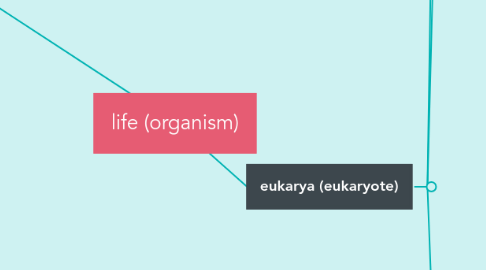
1. prokaryote
1.1. Oldest organisms living on earth. Cell membranes and wall lack peptidoglycan. Cell walls are much more resistance to physical and chemical disruption than those of other organism. As a result, Archaea inhabit extreme environments: hot springs arctic ice highly acidic water intestines of mammals They do not cause disease.
1.2. Archaea
1.3. Bacteria
1.3.1. Bacteria have 3 common shapes: Coccus (round) Bacillus (rod-shaped) Spirillum (spiral)
1.3.2. -Cytoplasm: composed of water, enzymes nutrients, wastes and gases. -Plasmid: Small loop of DNA that carries a small number of genes, floating in the cytoplasm (no true nucleus) -single circular chromosome. -Ribosomes: for building proteins. -Pilli: small hair like structures that help the cell attach to other cells or surfaces. -Flagella: used for movement.
1.3.3. Cell wall: plasma membrane peptidoglycan layer (long chains) outer membrane capsule and plasma membrane: surround cytoplasm
1.3.4. A stain called Gram Stain, is a technique used to differentiate two large groups of bacteria based on their different cell wall makeup. Gram-Positive bacteria have a thick peptidoglycan layer on their cell wall and stain purple. Gram-Negative bacteria have a thin peptidoglycan layer on their cell wall and stain pink.
1.3.5. They often occur in the following arrangements: Diplo- Pairs Staphylo- Clumps Strapto- Strings
1.3.6. Most are heterotrophic: Cannot manufacture its own food and instead obtains its food and energy by taking in organic substances eg. parasites Some are autotrophic: Make their own food. Photoautotrophs - are capable of synthesizing their own food from inorganic substances using light as an energy source. Chemoautotrophs - are capable of synthesizing their own food from inorganic substances using the oxidation of electrons as an energy source.
1.3.7. Three Types: Obligate Aerobes: Bacteria that need Oxygen to live. Facultative Aerobes: Bacteria that makes energy by aerobic respiration if oxygen is present, but is capable of switching to anaerobic respiration if oxygen is not present. Obligate Anaerobes: Bacteria that cannot live in environments where there is oxygen or they will die.
2. eukarya (eukaryote)
2.1. single cellular
2.1.1. protista
2.1.1.1. algae
2.1.1.1.1. -Unicellular or multicellular -Autotrophs - contain chlorophyll or other pigments (can photosynthesize). -Red algae can be used to make agar, food thickener, medicine capsules -May live alone or in colonies -Survive in great depths of the ocean.
2.1.1.2. Amoeba
2.1.1.2.1. -Live in freshwater lakes, ponds, damp soil -Shapeless, single-celled organisms. -Move using pseudopods. -Engulf their food with their bodies (heterotrophs). -Reproduces by splitting into two equal parts. -Responds to stimuli – can sense light and move away from it.
2.1.1.3. ciliates (paramecium)
2.1.1.3.1. - Found in freshwater ponds with a lot of decomposition. -Heterotroph. -Use cilia for movement. -Cilia also pull food towards the oral groove; which then encloses the food in a vacuole -May reproduce through fission or conjugation.
2.1.1.4. flagellates
2.1.1.4.1. -Move using flagella (tails). -Many are parasitic and can be found in the blood or intestines of host organisms. -Some are able to respond to light stimulus. -Capable of sexual or asexual reproduction.
2.1.1.5. slime moulds
2.1.1.5.1. ~Plasmodial -made from one large cell. -can be seen on decaying plant material in forests and fields. -may have many nuclei in their single cell. ~Cellular -single-celled protists that can join together to.work as a single organism, therefore can only be seen when they gather in a clump. -Survive as decomposers; can engulf other particles -Moves very slowly. -Consumes dead material.
2.1.1.6. water moulds
2.1.1.6.1. - Most live on decaying organic matter. -Unicellular organisms. -Reproduce sexually or asexually. -Made of branching strands of cells. -Can be parasites of plants or fish – extend their threads into the host tissues to absorb nutrients.
2.1.1.7. eulgena
2.1.1.7.1. -Either autotrophs or photosynthetic -Unicellular -Usually have two flagella for moving moves toward the light - positive phototropism -Has a red eyespot, which is light sensitive
2.1.1.8. diatoms
2.1.1.8.1. -Freshwater and marine environments -Unicellular -Asexual or sexual reproduction -Shells made of silica -Produce large amounts of oxygen
2.1.1.9. Dinoflagelates
2.1.1.9.1. -Live in marine environments. -May be bioluminescent (emit light). -Can cause the phenomenon referred to as red tide.
2.1.1.10. -There is not “typical” protist. -Protists identify to eukaryotic organisms, meaning having membrane-bound organelles within their cell membranes and a nucleus. -The only characteristic that all protists share is that they cannot be classified as animals, plants or fungi. -Exhibit a wide variety of cell features, different ways of moving, obtaining nutrients and reproducing. -Range in size from microscopic unicellular organisms to giant multicellular species.
2.2. ferns
2.2.1. -Lycophytes (club mosses) and Pterophytes (ferns) are a group of VASCULAR, SEEDLESS plants -Have vessels to transport food and water (xylem and phloem) -They have roots, stems or leaves
2.3. Multicellular
2.3.1. fungi
2.3.1.1. chytrids
2.3.1.1.1. - Primitive fungi -spores are zoospores -A zoospore is a motile asexual spore that uses a flagellum for locomotion -decomposers -single or multicellular eukaryotes -found in marine and freshwater ecosystem, as well as damp soil.
2.3.1.2. zygospore
2.3.1.2.1. -many are parasites of insects (used commercially as a pesticide) -soil fungi -include bread and fruit molds, reproduce sexually (meiosi) or asexually (mitosis)
2.3.1.3. AM fungi
2.3.1.3.1. -Soil borne fungi. -Form symbiotic relationship with plant roots. -Essential to ecosystem function - water, nutrient uptake by plants e.g. Mycorrhizae
2.3.1.4. sac fungi
2.3.1.4.1. -Together with Basidiomycota form the largest phylum of fungi -asexual reproduction - spore shooters (produces ascus). E.g. yeast, truffles and morels (can also be classified as Ascomycota or sac fungi). -produce their spores, called ascospores, in special pods or sac-like structures called asci (singular ascus)
2.3.1.5. club fungi
2.3.1.5.1. - Decomposers -Symbiotic relationship with plants -Reproduce sexually; sometimes asexually -Spores are basidiomycetes -most familiar fungi e.g. mushrooms, toadstools, puffballs
2.3.1.6. -Fungi (singular; fungus) -Like plants, fungi are … ~Sessile (stationary) ~Multicellular eukaryotes ~Grown in the ground -Unlike plants, fungi are ~Heterotrophs
2.3.2. Aves (birds)
2.3.3. Plantae
2.3.3.1. plants
2.3.3.1.1. mosses and liverworts
2.3.3.1.2. angiosperms
2.3.3.1.3. Gymnosperms
2.3.4. Animalia
2.3.4.1. eumetazoa
2.3.4.1.1. radiata
2.3.4.1.2. Bilateria

